BSS017-2 Sustainable Business Management Report: Amazon Analysis
VerifiedAdded on 2023/06/08
|7
|1608
|435
Report
AI Summary
This report provides a comprehensive overview of Amazon's approach to sustainable business management. It begins with an introduction to the concept of sustainable business and its importance, setting the stage for an analysis of Amazon's practices. The main body of the report delves into the waste hierarchy framework, explaining how Amazon utilizes it to achieve sustainability across its operations, including prevention, reuse, recycling, energy recovery, and disposal. Furthermore, the report elaborates on the key sustainable challenges faced by Amazon, categorized into economic, social, and environmental aspects. It explores the complexities of achieving net-zero carbon emissions, managing stakeholder expectations, and addressing environmental impacts. The report concludes by summarizing the findings and emphasizing the significance of sustainable business management for Amazon's long-term success and its relationship with various business constituents. The report references several journals and books to support its analysis.
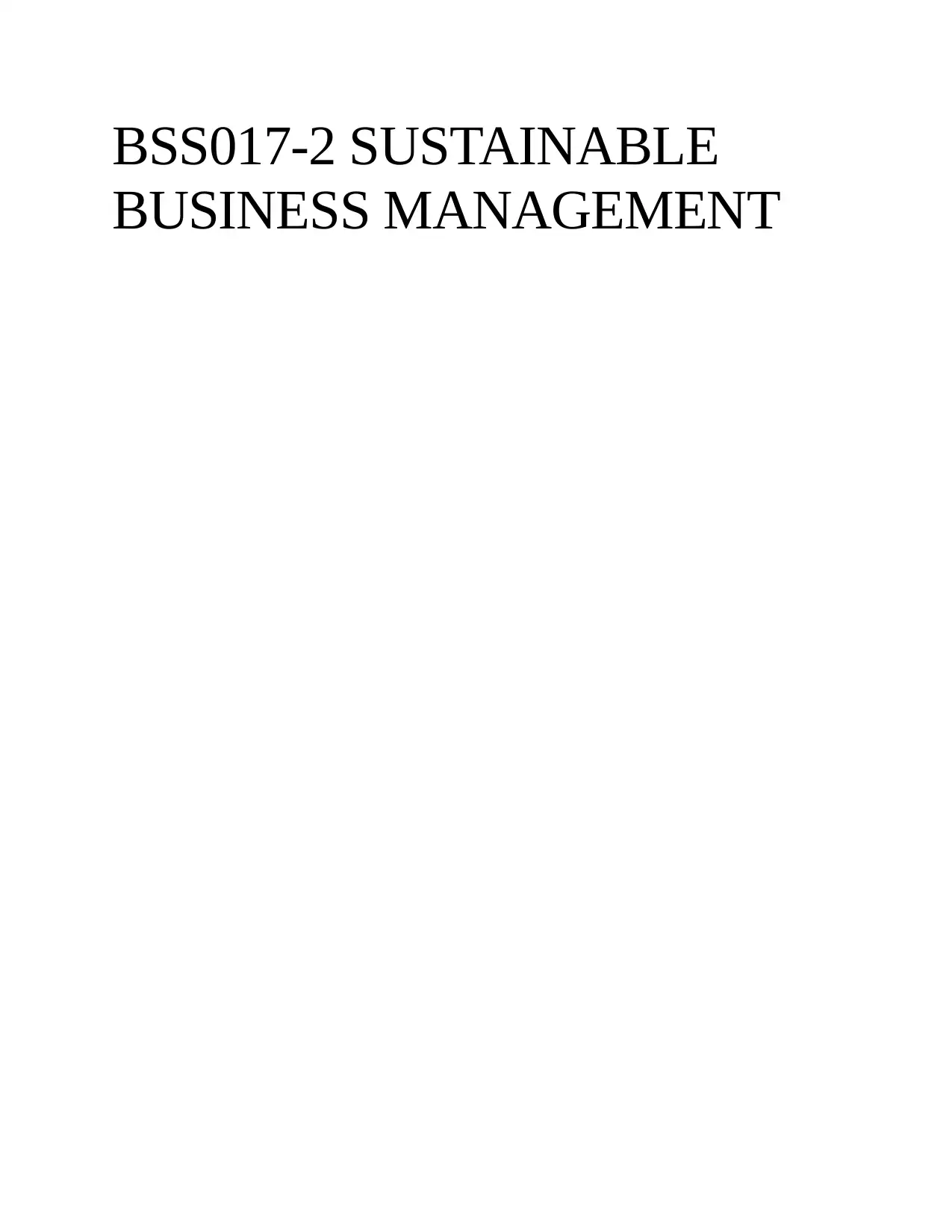
BSS017-2 SUSTAINABLE
BUSINESS MANAGEMENT
BUSINESS MANAGEMENT
Paraphrase This Document
Need a fresh take? Get an instant paraphrase of this document with our AI Paraphraser
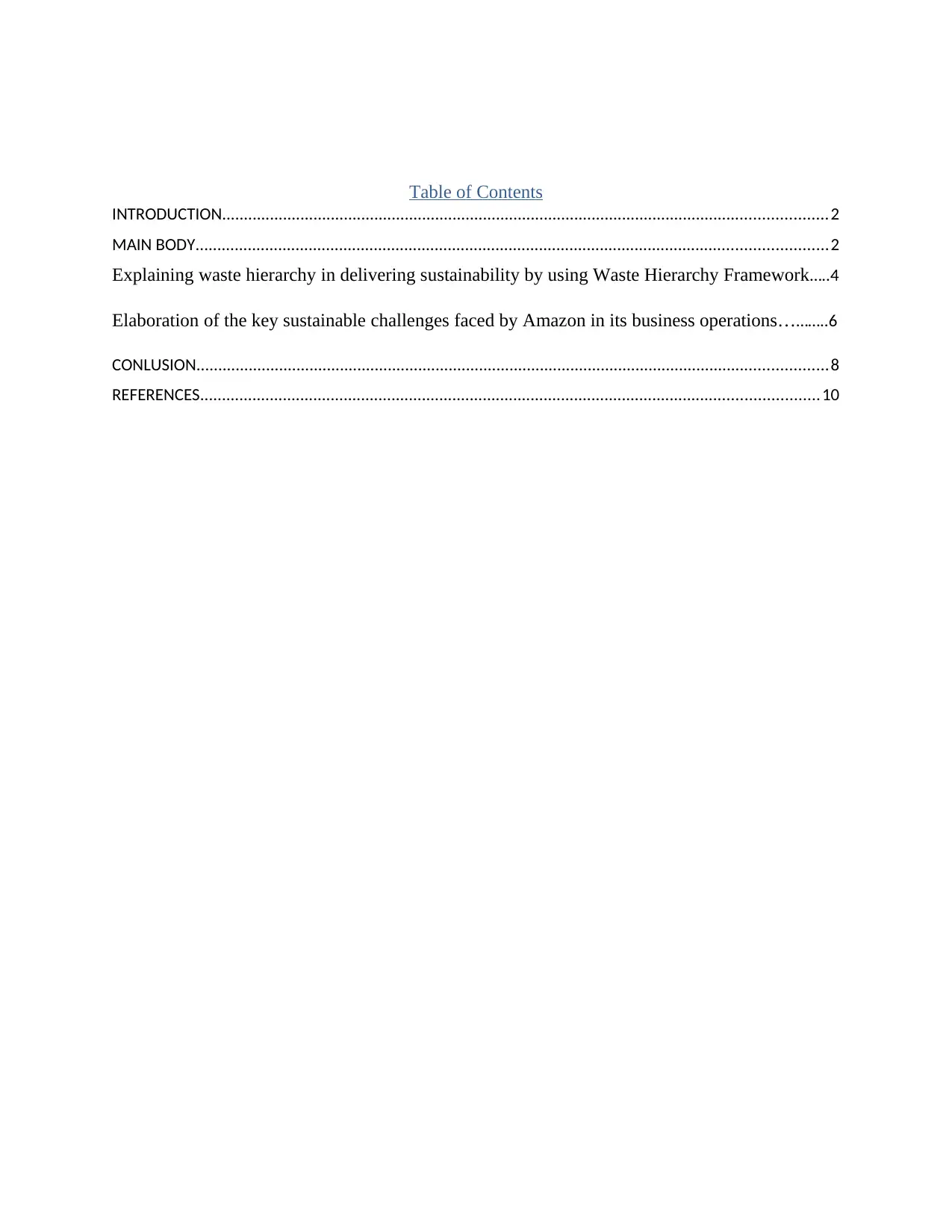
Table of Contents
INTRODUCTION...........................................................................................................................................2
MAIN BODY.................................................................................................................................................2
Explaining waste hierarchy in delivering sustainability by using Waste Hierarchy Framework…..4
Elaboration of the key sustainable challenges faced by Amazon in its business operations………..6
CONLUSION.................................................................................................................................................8
REFERENCES..............................................................................................................................................10
INTRODUCTION...........................................................................................................................................2
MAIN BODY.................................................................................................................................................2
Explaining waste hierarchy in delivering sustainability by using Waste Hierarchy Framework…..4
Elaboration of the key sustainable challenges faced by Amazon in its business operations………..6
CONLUSION.................................................................................................................................................8
REFERENCES..............................................................................................................................................10
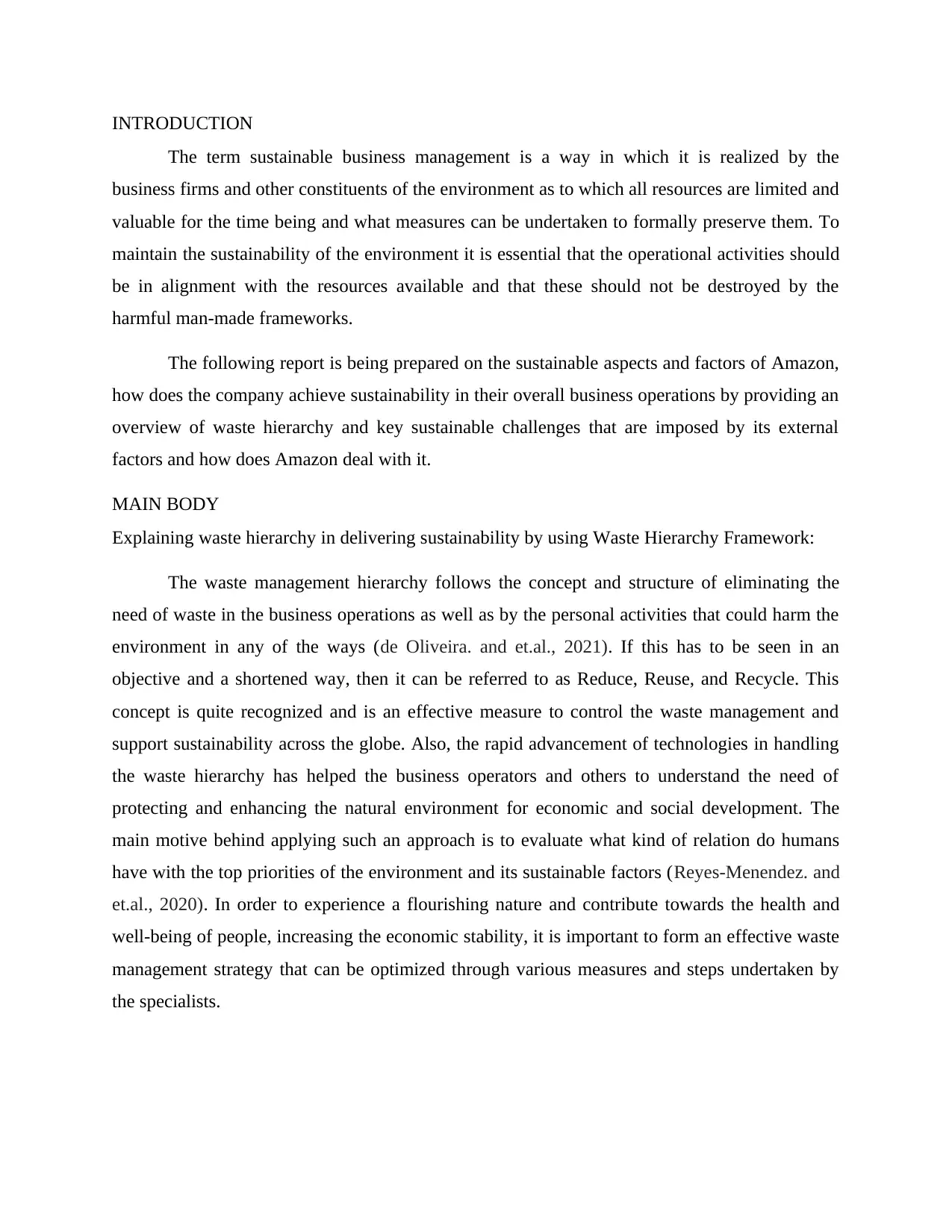
INTRODUCTION
The term sustainable business management is a way in which it is realized by the
business firms and other constituents of the environment as to which all resources are limited and
valuable for the time being and what measures can be undertaken to formally preserve them. To
maintain the sustainability of the environment it is essential that the operational activities should
be in alignment with the resources available and that these should not be destroyed by the
harmful man-made frameworks.
The following report is being prepared on the sustainable aspects and factors of Amazon,
how does the company achieve sustainability in their overall business operations by providing an
overview of waste hierarchy and key sustainable challenges that are imposed by its external
factors and how does Amazon deal with it.
MAIN BODY
Explaining waste hierarchy in delivering sustainability by using Waste Hierarchy Framework:
The waste management hierarchy follows the concept and structure of eliminating the
need of waste in the business operations as well as by the personal activities that could harm the
environment in any of the ways (de Oliveira. and et.al., 2021). If this has to be seen in an
objective and a shortened way, then it can be referred to as Reduce, Reuse, and Recycle. This
concept is quite recognized and is an effective measure to control the waste management and
support sustainability across the globe. Also, the rapid advancement of technologies in handling
the waste hierarchy has helped the business operators and others to understand the need of
protecting and enhancing the natural environment for economic and social development. The
main motive behind applying such an approach is to evaluate what kind of relation do humans
have with the top priorities of the environment and its sustainable factors (Reyes-Menendez. and
et.al., 2020). In order to experience a flourishing nature and contribute towards the health and
well-being of people, increasing the economic stability, it is important to form an effective waste
management strategy that can be optimized through various measures and steps undertaken by
the specialists.
The term sustainable business management is a way in which it is realized by the
business firms and other constituents of the environment as to which all resources are limited and
valuable for the time being and what measures can be undertaken to formally preserve them. To
maintain the sustainability of the environment it is essential that the operational activities should
be in alignment with the resources available and that these should not be destroyed by the
harmful man-made frameworks.
The following report is being prepared on the sustainable aspects and factors of Amazon,
how does the company achieve sustainability in their overall business operations by providing an
overview of waste hierarchy and key sustainable challenges that are imposed by its external
factors and how does Amazon deal with it.
MAIN BODY
Explaining waste hierarchy in delivering sustainability by using Waste Hierarchy Framework:
The waste management hierarchy follows the concept and structure of eliminating the
need of waste in the business operations as well as by the personal activities that could harm the
environment in any of the ways (de Oliveira. and et.al., 2021). If this has to be seen in an
objective and a shortened way, then it can be referred to as Reduce, Reuse, and Recycle. This
concept is quite recognized and is an effective measure to control the waste management and
support sustainability across the globe. Also, the rapid advancement of technologies in handling
the waste hierarchy has helped the business operators and others to understand the need of
protecting and enhancing the natural environment for economic and social development. The
main motive behind applying such an approach is to evaluate what kind of relation do humans
have with the top priorities of the environment and its sustainable factors (Reyes-Menendez. and
et.al., 2020). In order to experience a flourishing nature and contribute towards the health and
well-being of people, increasing the economic stability, it is important to form an effective waste
management strategy that can be optimized through various measures and steps undertaken by
the specialists.
⊘ This is a preview!⊘
Do you want full access?
Subscribe today to unlock all pages.

Trusted by 1+ million students worldwide
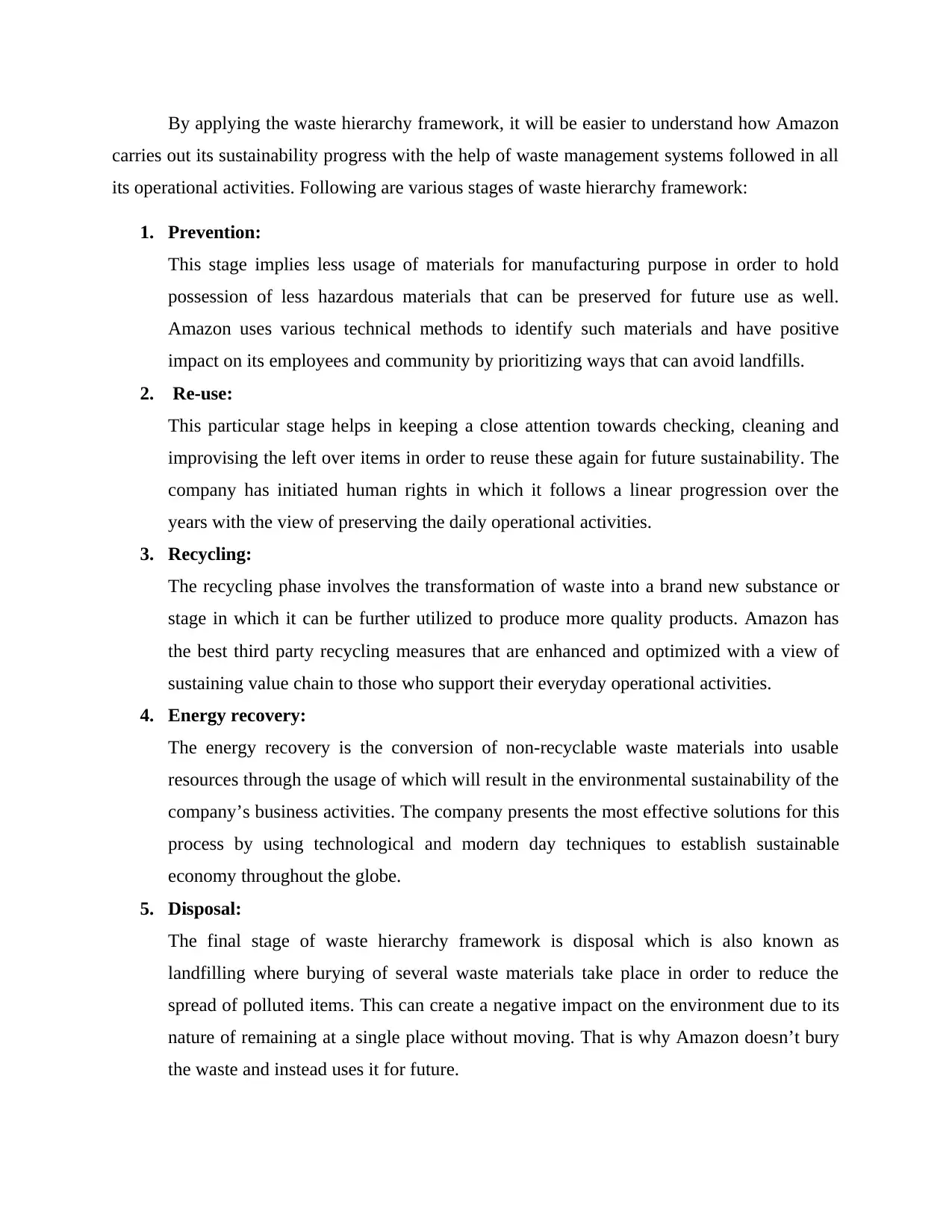
By applying the waste hierarchy framework, it will be easier to understand how Amazon
carries out its sustainability progress with the help of waste management systems followed in all
its operational activities. Following are various stages of waste hierarchy framework:
1. Prevention:
This stage implies less usage of materials for manufacturing purpose in order to hold
possession of less hazardous materials that can be preserved for future use as well.
Amazon uses various technical methods to identify such materials and have positive
impact on its employees and community by prioritizing ways that can avoid landfills.
2. Re-use:
This particular stage helps in keeping a close attention towards checking, cleaning and
improvising the left over items in order to reuse these again for future sustainability. The
company has initiated human rights in which it follows a linear progression over the
years with the view of preserving the daily operational activities.
3. Recycling:
The recycling phase involves the transformation of waste into a brand new substance or
stage in which it can be further utilized to produce more quality products. Amazon has
the best third party recycling measures that are enhanced and optimized with a view of
sustaining value chain to those who support their everyday operational activities.
4. Energy recovery:
The energy recovery is the conversion of non-recyclable waste materials into usable
resources through the usage of which will result in the environmental sustainability of the
company’s business activities. The company presents the most effective solutions for this
process by using technological and modern day techniques to establish sustainable
economy throughout the globe.
5. Disposal:
The final stage of waste hierarchy framework is disposal which is also known as
landfilling where burying of several waste materials take place in order to reduce the
spread of polluted items. This can create a negative impact on the environment due to its
nature of remaining at a single place without moving. That is why Amazon doesn’t bury
the waste and instead uses it for future.
carries out its sustainability progress with the help of waste management systems followed in all
its operational activities. Following are various stages of waste hierarchy framework:
1. Prevention:
This stage implies less usage of materials for manufacturing purpose in order to hold
possession of less hazardous materials that can be preserved for future use as well.
Amazon uses various technical methods to identify such materials and have positive
impact on its employees and community by prioritizing ways that can avoid landfills.
2. Re-use:
This particular stage helps in keeping a close attention towards checking, cleaning and
improvising the left over items in order to reuse these again for future sustainability. The
company has initiated human rights in which it follows a linear progression over the
years with the view of preserving the daily operational activities.
3. Recycling:
The recycling phase involves the transformation of waste into a brand new substance or
stage in which it can be further utilized to produce more quality products. Amazon has
the best third party recycling measures that are enhanced and optimized with a view of
sustaining value chain to those who support their everyday operational activities.
4. Energy recovery:
The energy recovery is the conversion of non-recyclable waste materials into usable
resources through the usage of which will result in the environmental sustainability of the
company’s business activities. The company presents the most effective solutions for this
process by using technological and modern day techniques to establish sustainable
economy throughout the globe.
5. Disposal:
The final stage of waste hierarchy framework is disposal which is also known as
landfilling where burying of several waste materials take place in order to reduce the
spread of polluted items. This can create a negative impact on the environment due to its
nature of remaining at a single place without moving. That is why Amazon doesn’t bury
the waste and instead uses it for future.
Paraphrase This Document
Need a fresh take? Get an instant paraphrase of this document with our AI Paraphraser
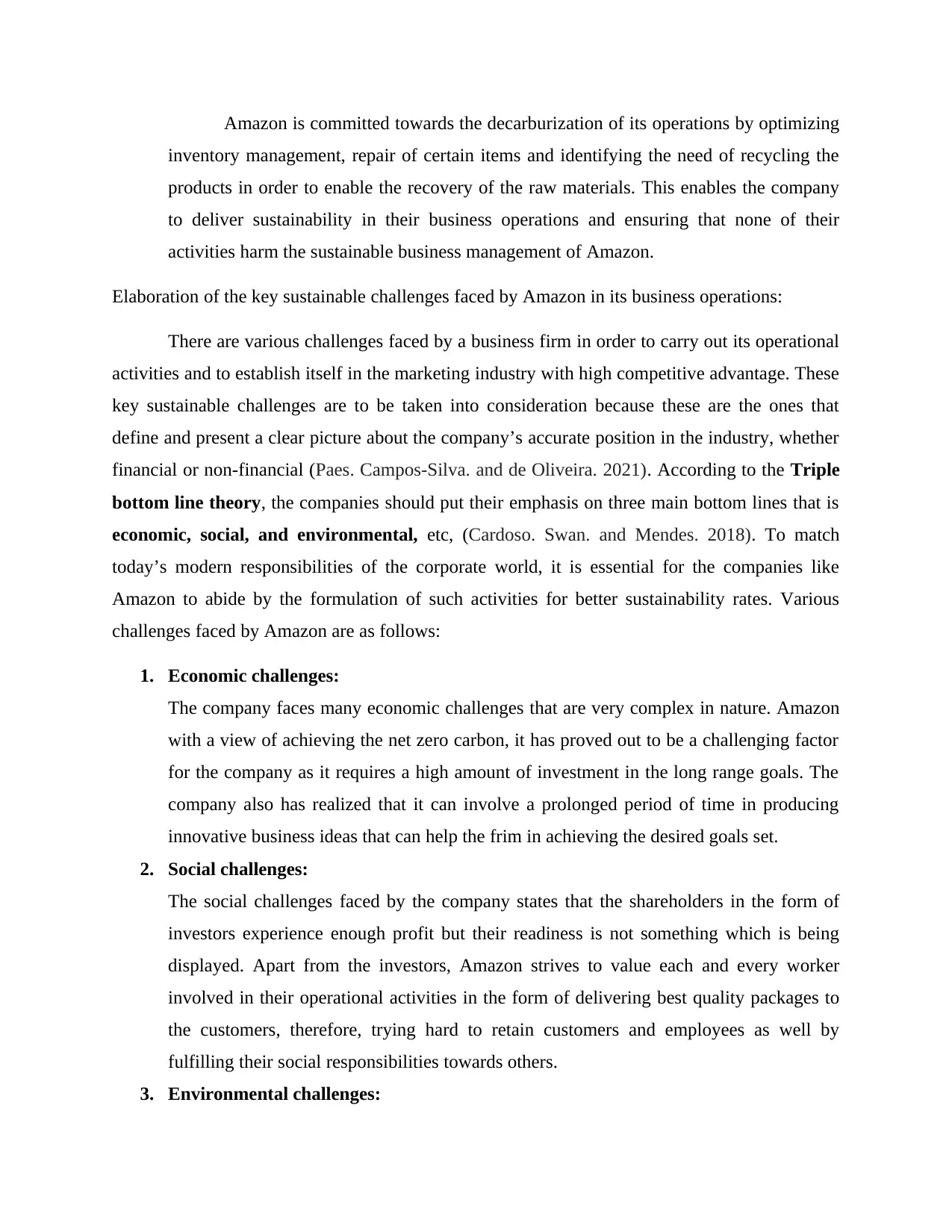
Amazon is committed towards the decarburization of its operations by optimizing
inventory management, repair of certain items and identifying the need of recycling the
products in order to enable the recovery of the raw materials. This enables the company
to deliver sustainability in their business operations and ensuring that none of their
activities harm the sustainable business management of Amazon.
Elaboration of the key sustainable challenges faced by Amazon in its business operations:
There are various challenges faced by a business firm in order to carry out its operational
activities and to establish itself in the marketing industry with high competitive advantage. These
key sustainable challenges are to be taken into consideration because these are the ones that
define and present a clear picture about the company’s accurate position in the industry, whether
financial or non-financial (Paes. Campos-Silva. and de Oliveira. 2021). According to the Triple
bottom line theory, the companies should put their emphasis on three main bottom lines that is
economic, social, and environmental, etc, (Cardoso. Swan. and Mendes. 2018). To match
today’s modern responsibilities of the corporate world, it is essential for the companies like
Amazon to abide by the formulation of such activities for better sustainability rates. Various
challenges faced by Amazon are as follows:
1. Economic challenges:
The company faces many economic challenges that are very complex in nature. Amazon
with a view of achieving the net zero carbon, it has proved out to be a challenging factor
for the company as it requires a high amount of investment in the long range goals. The
company also has realized that it can involve a prolonged period of time in producing
innovative business ideas that can help the frim in achieving the desired goals set.
2. Social challenges:
The social challenges faced by the company states that the shareholders in the form of
investors experience enough profit but their readiness is not something which is being
displayed. Apart from the investors, Amazon strives to value each and every worker
involved in their operational activities in the form of delivering best quality packages to
the customers, therefore, trying hard to retain customers and employees as well by
fulfilling their social responsibilities towards others.
3. Environmental challenges:
inventory management, repair of certain items and identifying the need of recycling the
products in order to enable the recovery of the raw materials. This enables the company
to deliver sustainability in their business operations and ensuring that none of their
activities harm the sustainable business management of Amazon.
Elaboration of the key sustainable challenges faced by Amazon in its business operations:
There are various challenges faced by a business firm in order to carry out its operational
activities and to establish itself in the marketing industry with high competitive advantage. These
key sustainable challenges are to be taken into consideration because these are the ones that
define and present a clear picture about the company’s accurate position in the industry, whether
financial or non-financial (Paes. Campos-Silva. and de Oliveira. 2021). According to the Triple
bottom line theory, the companies should put their emphasis on three main bottom lines that is
economic, social, and environmental, etc, (Cardoso. Swan. and Mendes. 2018). To match
today’s modern responsibilities of the corporate world, it is essential for the companies like
Amazon to abide by the formulation of such activities for better sustainability rates. Various
challenges faced by Amazon are as follows:
1. Economic challenges:
The company faces many economic challenges that are very complex in nature. Amazon
with a view of achieving the net zero carbon, it has proved out to be a challenging factor
for the company as it requires a high amount of investment in the long range goals. The
company also has realized that it can involve a prolonged period of time in producing
innovative business ideas that can help the frim in achieving the desired goals set.
2. Social challenges:
The social challenges faced by the company states that the shareholders in the form of
investors experience enough profit but their readiness is not something which is being
displayed. Apart from the investors, Amazon strives to value each and every worker
involved in their operational activities in the form of delivering best quality packages to
the customers, therefore, trying hard to retain customers and employees as well by
fulfilling their social responsibilities towards others.
3. Environmental challenges:
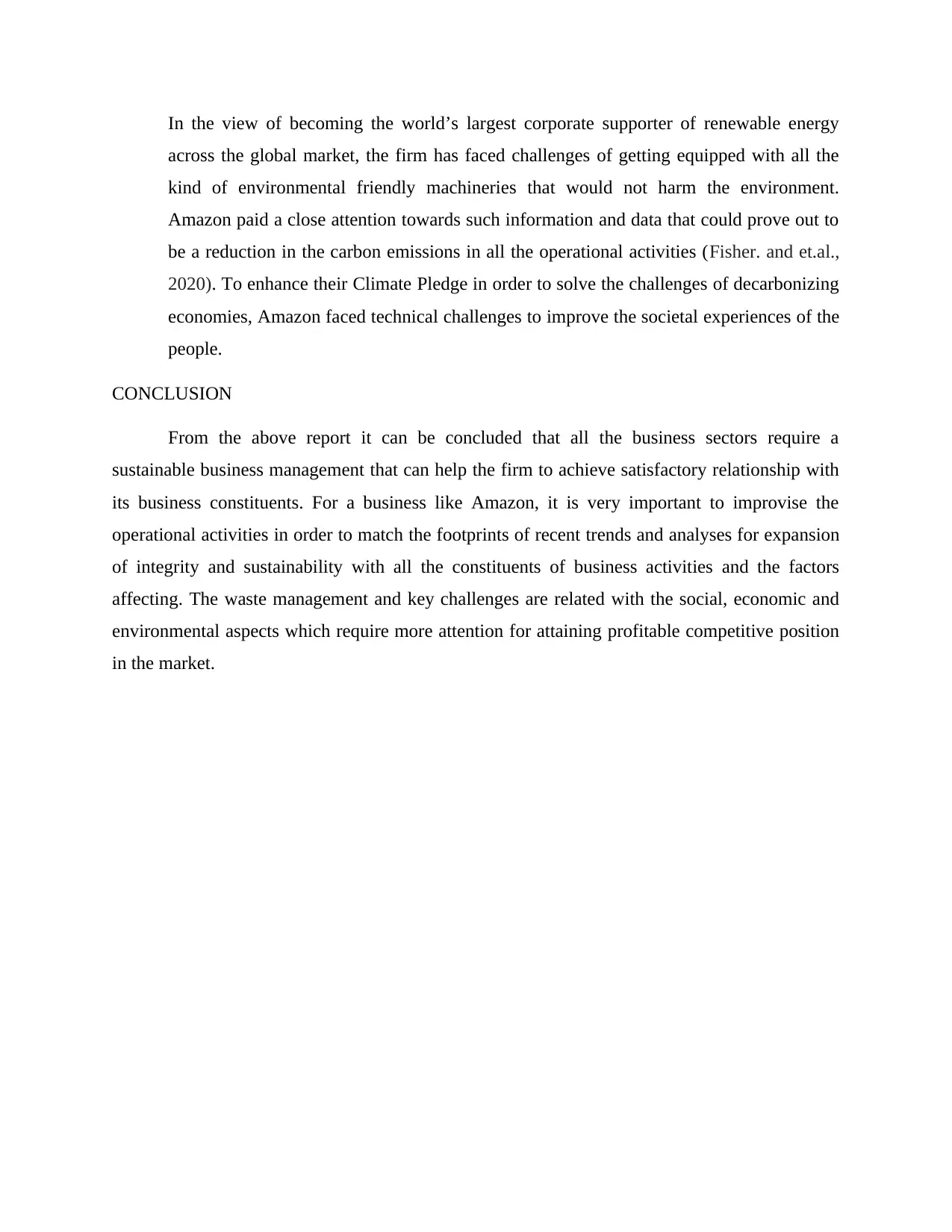
In the view of becoming the world’s largest corporate supporter of renewable energy
across the global market, the firm has faced challenges of getting equipped with all the
kind of environmental friendly machineries that would not harm the environment.
Amazon paid a close attention towards such information and data that could prove out to
be a reduction in the carbon emissions in all the operational activities (Fisher. and et.al.,
2020). To enhance their Climate Pledge in order to solve the challenges of decarbonizing
economies, Amazon faced technical challenges to improve the societal experiences of the
people.
CONCLUSION
From the above report it can be concluded that all the business sectors require a
sustainable business management that can help the firm to achieve satisfactory relationship with
its business constituents. For a business like Amazon, it is very important to improvise the
operational activities in order to match the footprints of recent trends and analyses for expansion
of integrity and sustainability with all the constituents of business activities and the factors
affecting. The waste management and key challenges are related with the social, economic and
environmental aspects which require more attention for attaining profitable competitive position
in the market.
across the global market, the firm has faced challenges of getting equipped with all the
kind of environmental friendly machineries that would not harm the environment.
Amazon paid a close attention towards such information and data that could prove out to
be a reduction in the carbon emissions in all the operational activities (Fisher. and et.al.,
2020). To enhance their Climate Pledge in order to solve the challenges of decarbonizing
economies, Amazon faced technical challenges to improve the societal experiences of the
people.
CONCLUSION
From the above report it can be concluded that all the business sectors require a
sustainable business management that can help the firm to achieve satisfactory relationship with
its business constituents. For a business like Amazon, it is very important to improvise the
operational activities in order to match the footprints of recent trends and analyses for expansion
of integrity and sustainability with all the constituents of business activities and the factors
affecting. The waste management and key challenges are related with the social, economic and
environmental aspects which require more attention for attaining profitable competitive position
in the market.
⊘ This is a preview!⊘
Do you want full access?
Subscribe today to unlock all pages.

Trusted by 1+ million students worldwide
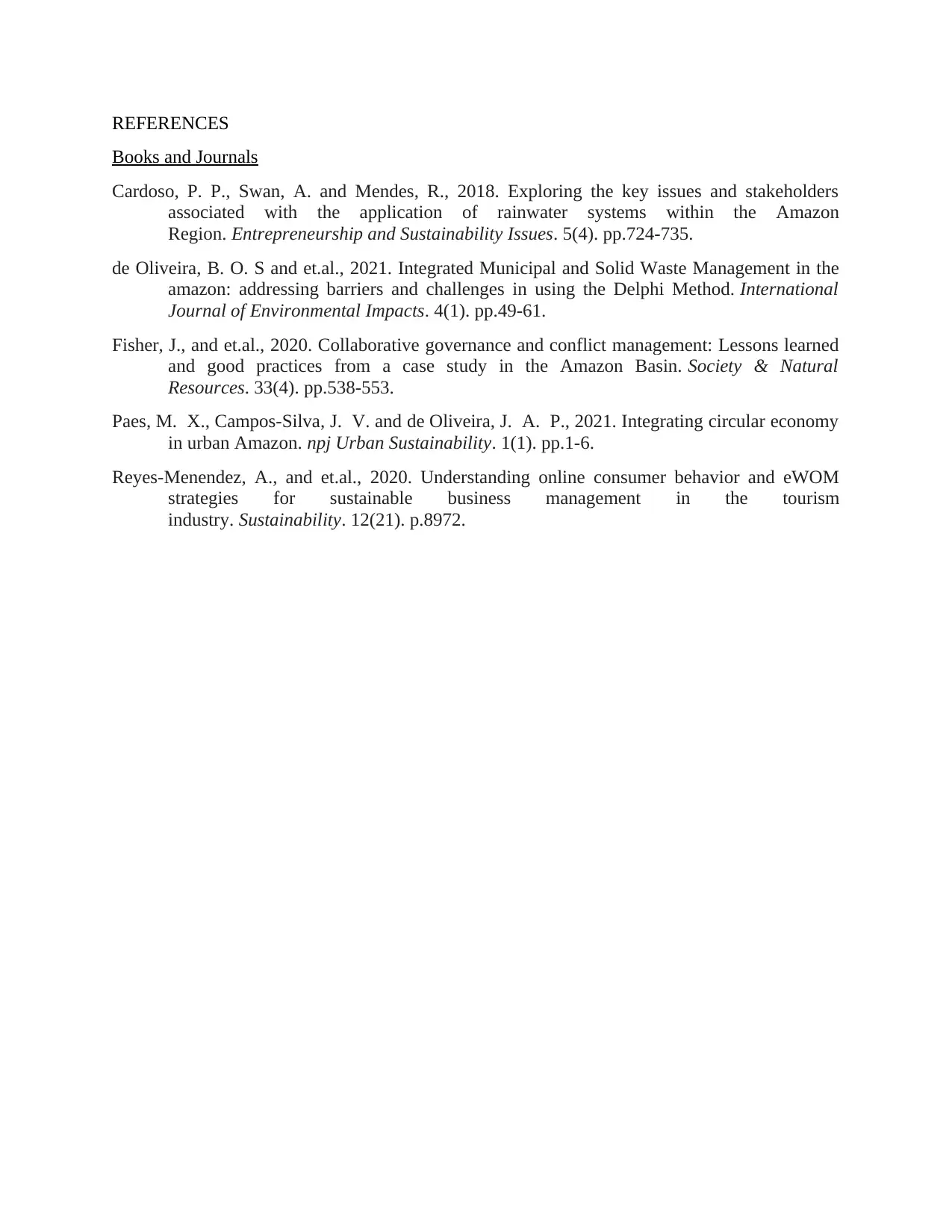
REFERENCES
Books and Journals
Cardoso, P. P., Swan, A. and Mendes, R., 2018. Exploring the key issues and stakeholders
associated with the application of rainwater systems within the Amazon
Region. Entrepreneurship and Sustainability Issues. 5(4). pp.724-735.
de Oliveira, B. O. S and et.al., 2021. Integrated Municipal and Solid Waste Management in the
amazon: addressing barriers and challenges in using the Delphi Method. International
Journal of Environmental Impacts. 4(1). pp.49-61.
Fisher, J., and et.al., 2020. Collaborative governance and conflict management: Lessons learned
and good practices from a case study in the Amazon Basin. Society & Natural
Resources. 33(4). pp.538-553.
Paes, M. X., Campos-Silva, J. V. and de Oliveira, J. A. P., 2021. Integrating circular economy
in urban Amazon. npj Urban Sustainability. 1(1). pp.1-6.
Reyes-Menendez, A., and et.al., 2020. Understanding online consumer behavior and eWOM
strategies for sustainable business management in the tourism
industry. Sustainability. 12(21). p.8972.
Books and Journals
Cardoso, P. P., Swan, A. and Mendes, R., 2018. Exploring the key issues and stakeholders
associated with the application of rainwater systems within the Amazon
Region. Entrepreneurship and Sustainability Issues. 5(4). pp.724-735.
de Oliveira, B. O. S and et.al., 2021. Integrated Municipal and Solid Waste Management in the
amazon: addressing barriers and challenges in using the Delphi Method. International
Journal of Environmental Impacts. 4(1). pp.49-61.
Fisher, J., and et.al., 2020. Collaborative governance and conflict management: Lessons learned
and good practices from a case study in the Amazon Basin. Society & Natural
Resources. 33(4). pp.538-553.
Paes, M. X., Campos-Silva, J. V. and de Oliveira, J. A. P., 2021. Integrating circular economy
in urban Amazon. npj Urban Sustainability. 1(1). pp.1-6.
Reyes-Menendez, A., and et.al., 2020. Understanding online consumer behavior and eWOM
strategies for sustainable business management in the tourism
industry. Sustainability. 12(21). p.8972.
1 out of 7
Related Documents
Your All-in-One AI-Powered Toolkit for Academic Success.
+13062052269
info@desklib.com
Available 24*7 on WhatsApp / Email
![[object Object]](/_next/static/media/star-bottom.7253800d.svg)
Unlock your academic potential
Copyright © 2020–2025 A2Z Services. All Rights Reserved. Developed and managed by ZUCOL.




